2012 VOLKSWAGEN GOLF MK6 tow
[x] Cancel search: towPage 159 of 516
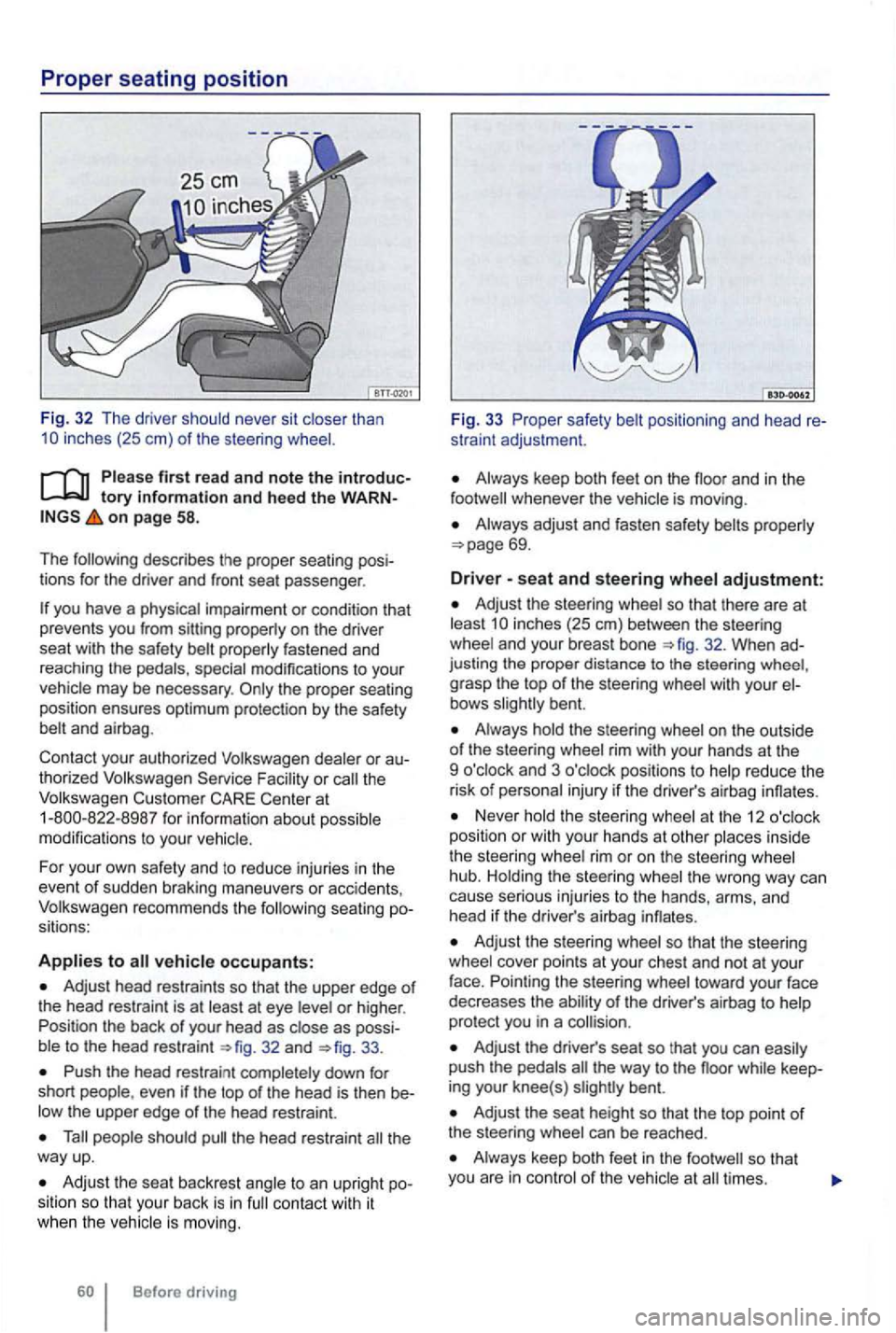
first rea d and note the introductory information and hee d the WARNon page 58.
The following describes the proper seating posi
tions for the driver and front seat passenger .
special modifications to your
vehicle may be necessary .
to
Adjust head restraints so that the upper edge of the head restraint is at least at eye
32 and 33.
Push the head restrai nt completely down for
short even if the top of the head is then be
people should the head restraint the way up.
Adjust the sea t backrest angle to an upright position so that your back is in contact with it when the veh icle is moving.
Before driving
Fig. 33 P roper safety
Always keep both feet on the whenever the vehicle is moving .
Always adjust and fasten safety belts properly
adjustment:
Adjust the steering whe el so that there are at least inches (25 em) between the steeri ng
wheel and your breast bone
grasp the top of the steering wheel with your bent.
Always hold the steering wheel on the outside of the steering wheel rim with your hands at the
9 o'clock and 3 o'clock positions to help reduce the
risk
of personal injury if the driver's airbag innates.
Never hold the steering wheel at the 12
and
head if th e driver's airbag innates.
Adjust the steering wheel so that the steering
wheel cover points at your chest and not at your
face. Pointing the steer ing wheel toward your face
dec reases the ability
of the driver's airbag to help
protec t you in a
Adjust the driver's seat so tha t you can easily push the pedals the way to the noor while keep
ing your knee(s) bent.
Adjust the seat height so that the top point o f
the steering wheel can be reached .
Always keep both feet in the times.
Page 163 of 516
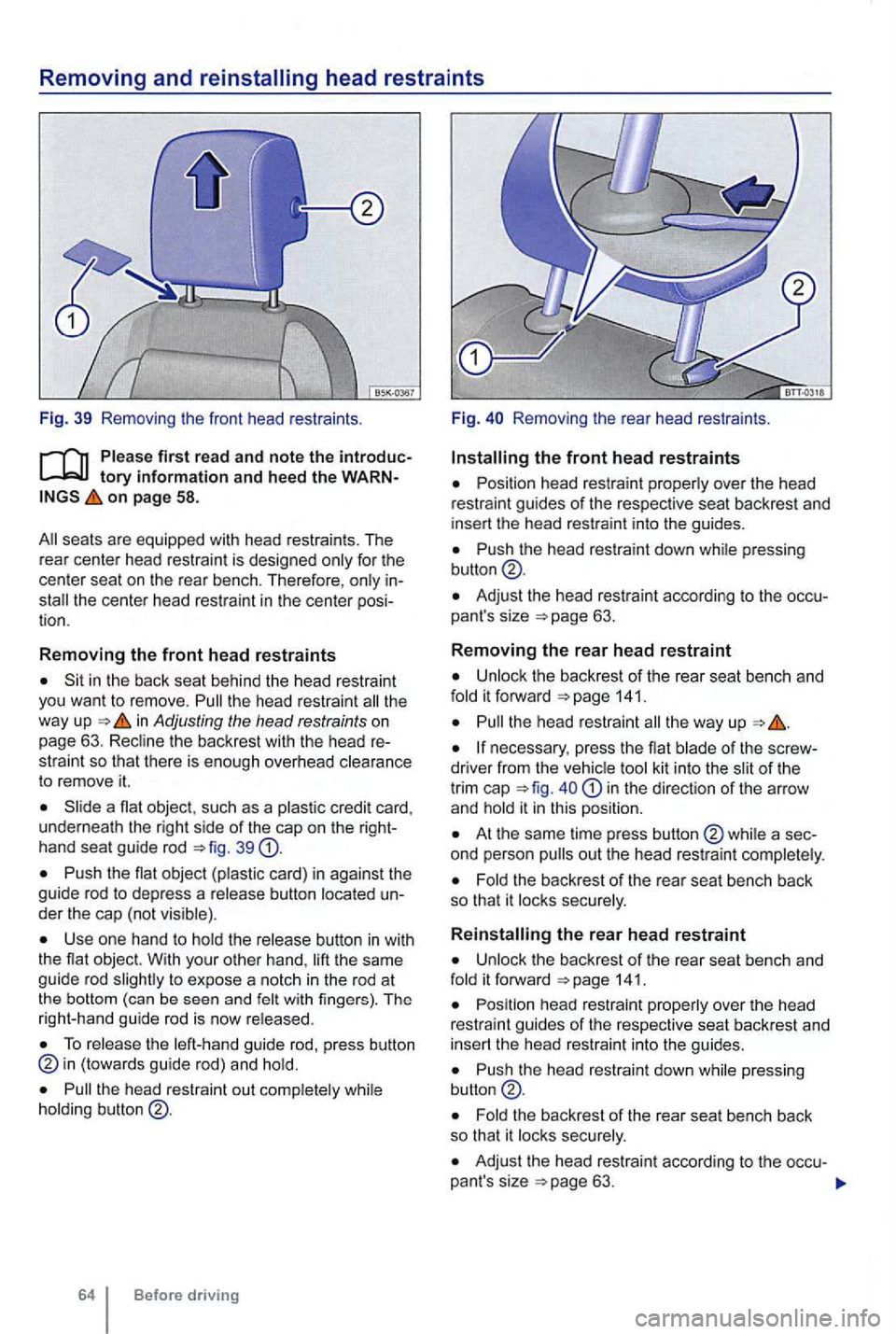
Removing and reinstalling head restra ints
Fig. 39 Remo ving the front head restraints .
on page 58.
for the
center seat on the rear bench . T he refore ,
Sit in the back seat behind the head restraint
you want to remove. the head restraint th e
way up in Adjusting the head restraints on
page 63. the backrest with the head re
stra int so that there is enough overhead
to remove it.
a nat object , such as a
button
Use one hand to the same
guide rod to expose a notc h in the rod at
t he bottom (can be seen and with fingers) . T he
r ight-hand guide rod is now
To the guide rod, p ress button (towards guide rod) and
the head restraint out
64 Before driving F
ig.
Removing the rear head restr aints .
Posi tion head restraint over the head
restr aint guides of the respective seat backrest and
i nsert the head restra int into the guides.
Push the head restraint down
Adjust the head rest raint according to the occu
pant's size 63.
Removing the rear head restraint
the backrest of the rear seat bench and it forward 141.
the head restrain t
necessary , press the nat of the scr ew
d river from the kit in to the of the
tr im cap in the direction of the arrow
and
At the same time press button
the back rest of the rea r seat bench back
so that it
it forward 141.
P osition head restraint over the head
restraint guides of the respective seat backrest and
i ns e
rt the head restrain t into the guides.
Push the head restraint down pressing
t he backres t of the rear seat bench back so that it
Adjust the head restraint according to the occu-
pant 's size
Page 164 of 516
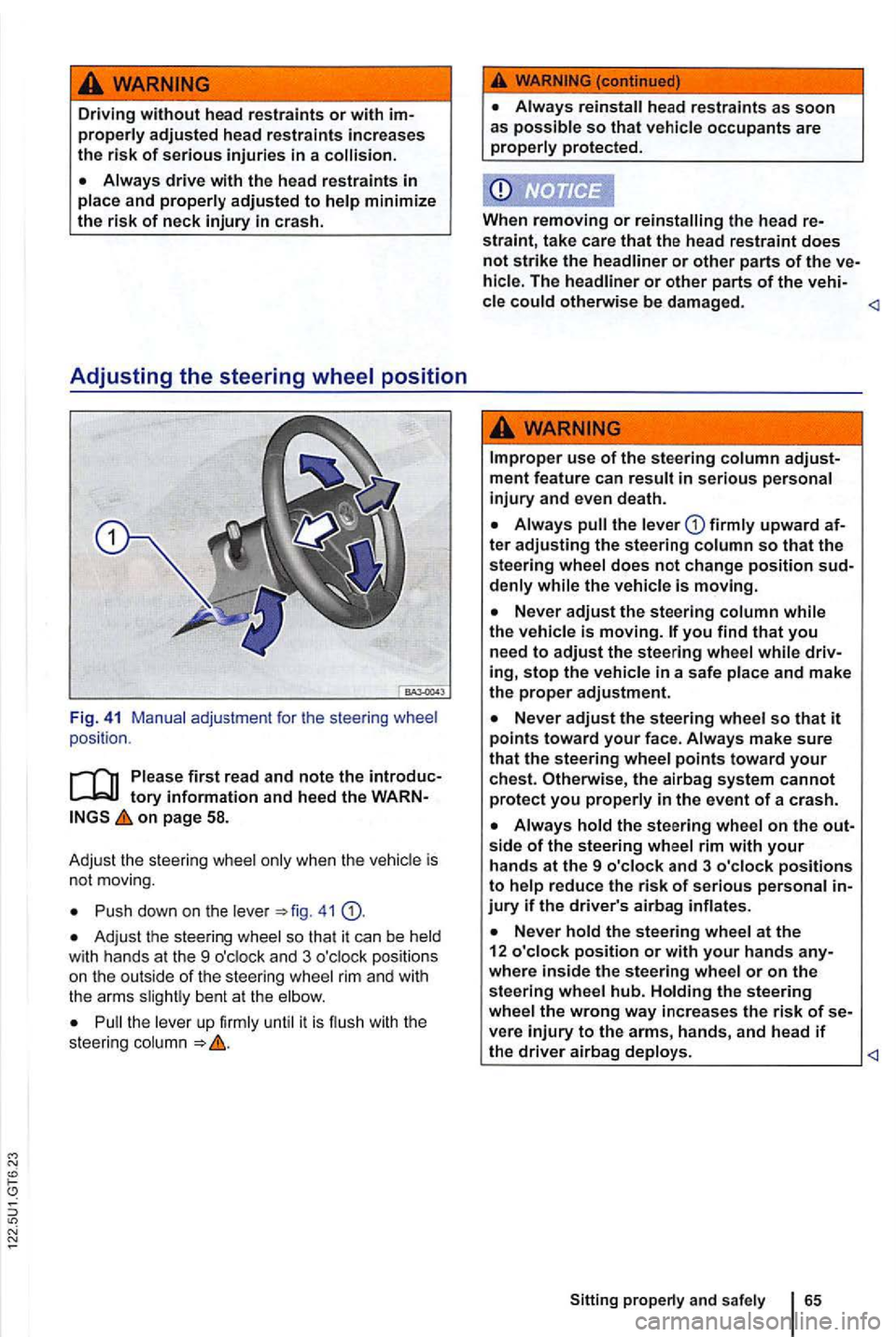
Driving without head restraints or with properly adjusted head restraints increases
the risk of serious injuries in a
tory information and heed the on page 58.
Adju st the steerin g whee l only w he n the veh icl e is
no t m ovi ng.
Push dow n o n the leve r 41
Adj ust th e steering whee l so th a t it ca n b e held w ith hands at the 9 o'cloc k and 3 o 'clock positio ns
o n the out side of the steering wheel rim and with
t he arms slightl y b ent at the elbow .
Pull the leve r up firml y until it is flu sh with th e
stee ring colum n
the lever
denly while the vehicle is moving.
Never adjust the steering wheel so that it points toward your face . Always make sure that the steering wheel points toward your chest. Otherwise, the airbag system cannot protect you properly in the event of a crash.
side of the steering wheel rim with your hands at the 9 o'clock and 3 o'clock positions to help reduce the risk of serious personal
where inside the steering wheel or on the steering wheel hub. Holding the steering wheel the wrong way increases the risk of vere injury to the arms, hands, and head if the driver airbag deploys.
Page 168 of 516
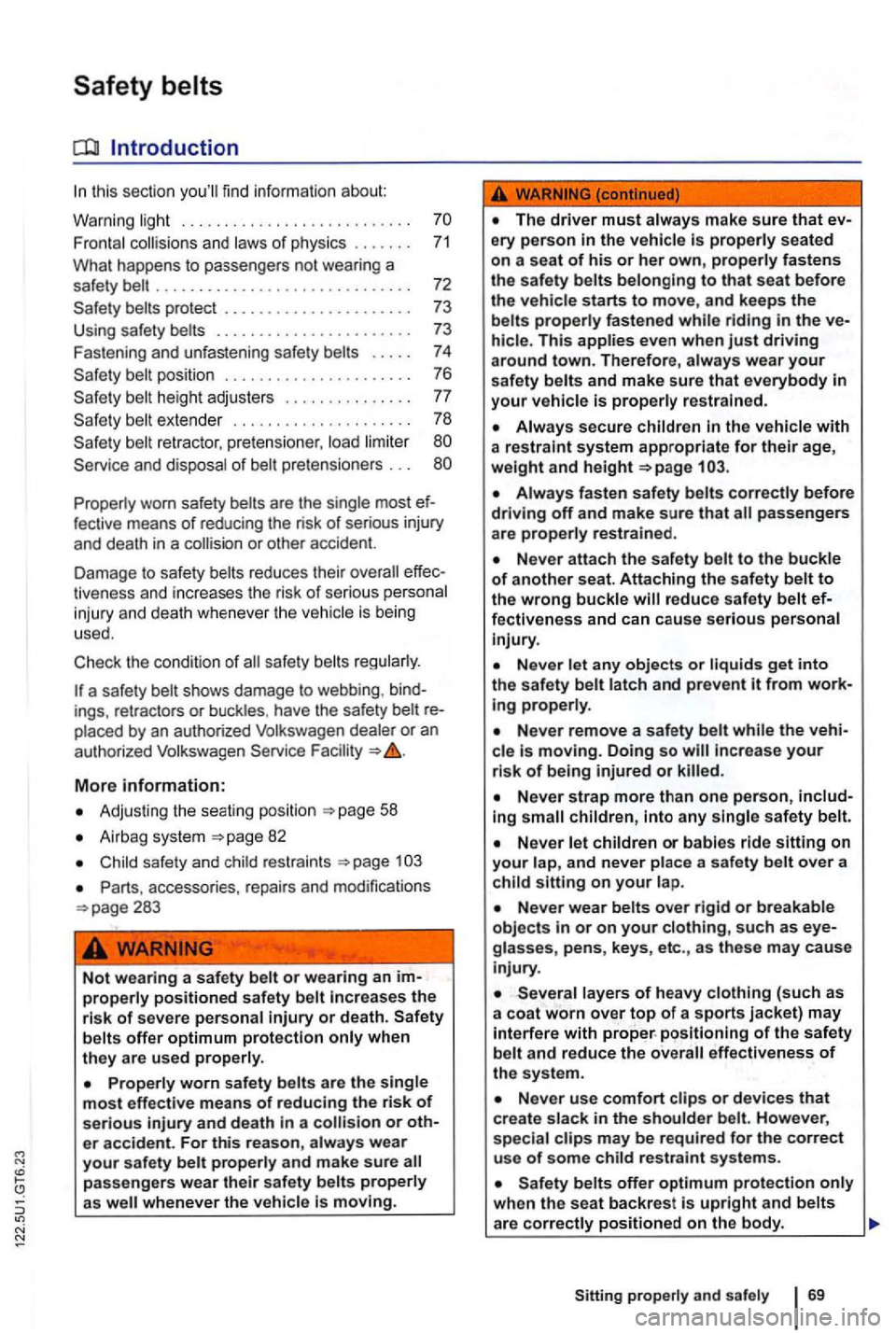
find informati on about:
Fro nt al
Properly worn safety fective means of reducing the risk of serious injury
and death in a or othe r accident.
D amage to sa fety belts reduces their
tiveness and increases the risk of se rious personal
i nj ury and death whenever the vehicle is being
used .
Check the conditi on of
a safe ty belt shows damage to webbing , ings, retracto rs or buckles . have the safety belt
More information:
Adjusting the seating posit io n
Airbag system
Child safety and child restraints 103
Parts , access ories, repai rs and modifications
Properly worn safety belts are the single most effective means of r educing the risk of serious injury and death in a collision or er accident. For this reason , always wear your safety belt properly and make sure all
pa ssengers wear their safety belts properly as well whenever the vehicle
The driver must always make sure that
hicle. Thi s applies even when just driving around town. Therefore, always wear your safety belts and make sure that everybody in your vehicle is properly restrained.
Always secure children
Always fasten safety belts correctly before driving off and make sure that all passengers
are properly re strained .
Never attach the safety belt to the buckle of another seat. Attaching the safety belt to the wrong buckle will reduce safety belt fectiveness and can cause serious personal injury.
cle is moving. Doing so will
small children, into any single safety belt.
Never wear belts over rigid or breakable objects in or on your clothing, such as glasses, pens, keys, etc., as these may cause injury.
layers of heavy clothing (such as
a coat worn over top of a sports jacket) may with proper. positioning of the safety belt and reduce the overall effectiveness of the system .
Never use comfort clips or devices that create slack in the shoulder belt. However,
s pecial clips may be required for the correc t
u se of some child res traint systems.
Page 169 of 516
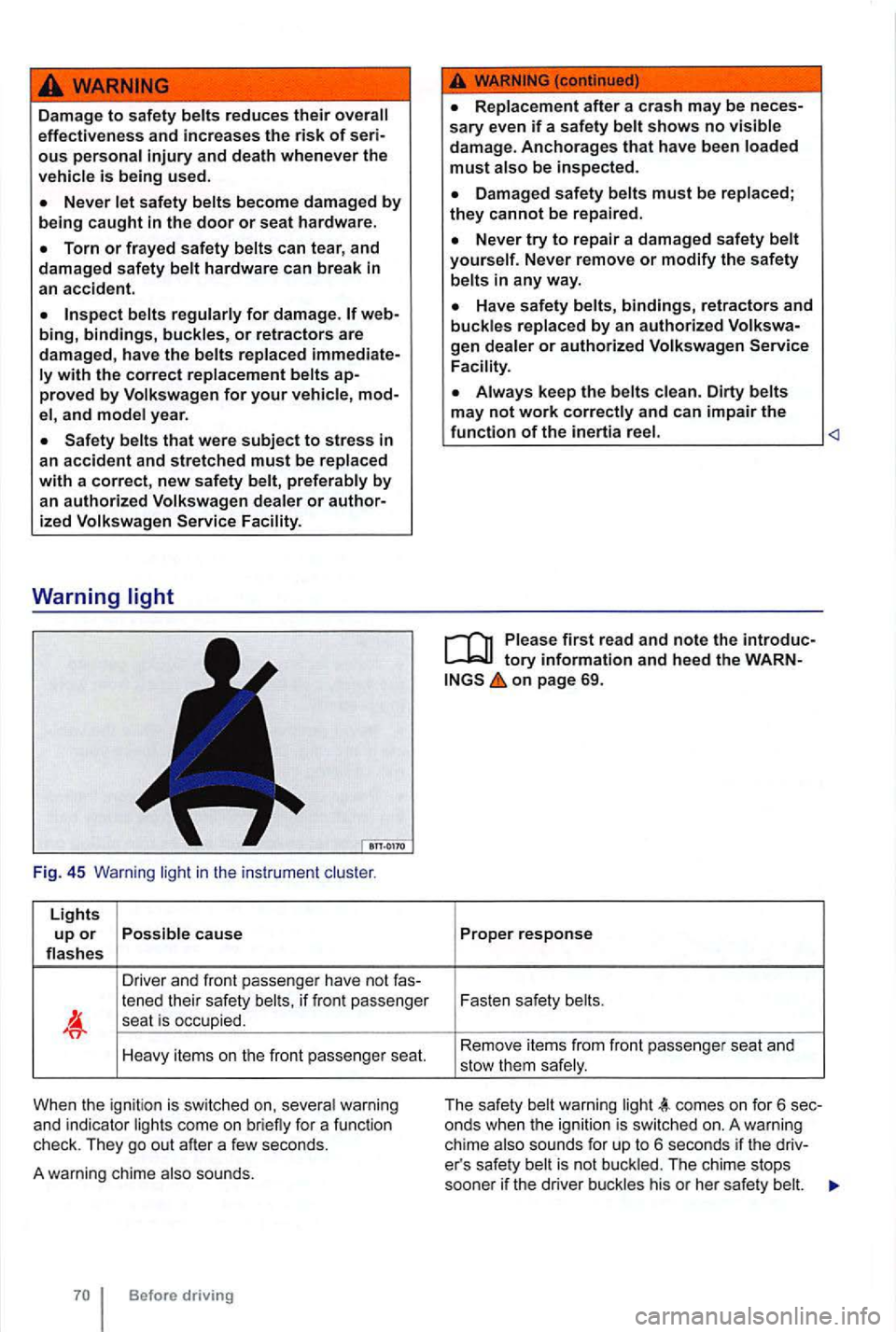
Damage to safety belts re duces their effective ne ss and increa ses the risk of serious personal injury and death whenever the
v ehicle is being used.
Torn or frayed safety belts can te ar, and
damag ed safety belt hardware can break
web
bing, bindings, buc kles, or retractors are damaged , hav e the belts replaced immediate
ly with the correct replacement belts proved by Volkswagen for your vehicle, model , and model yea r.
Fig . 45 Warning light in the instrume nt
Lights up or Possible caus e flas hes
Driver and front p asse nge r have not
tened their safety belts, if fr o nt passenger sea t is occup ied.
Heavy items on the front passe nge r seat.
Whe n the ign itio n is switched on, seve ra l warni ng
and indica tor lights come on brie fly for a func tion
check. They go out after a few seconds.
A warning chime also sounds.
Replacement after a crash may be neces
s ary even if a sa fety belt shows no visible damag e. Anchorages that have been loaded must also be inspect ed .
D amaged safety belts must be replaced ; they cannot be repaired .
Never try to repair a dam ag ed s afety belt yourself. Never remove or modify the safety
belts in any way.
Have safety belts, bindings, retractors and buckles replaced by an authorized
Always keep the belts clean . Dirty belts
may not work
tory information and heed the WARNon page 69.
Proper response
Fasten safety belts .
Re move it e m s f
rom fr ont passe nger seat and
stow them safe ly .
T
he safety belt wa rnin g light comes on f or 6 sec
onds when the ignition is sw itched on. A warning
ch ime also sounds for up to 6 seco nds if the driver's safe ty belt is not bu ckl ed . Th e c hime stops
soone r if the driver buckles his or her safe ty be lt.
Page 174 of 516
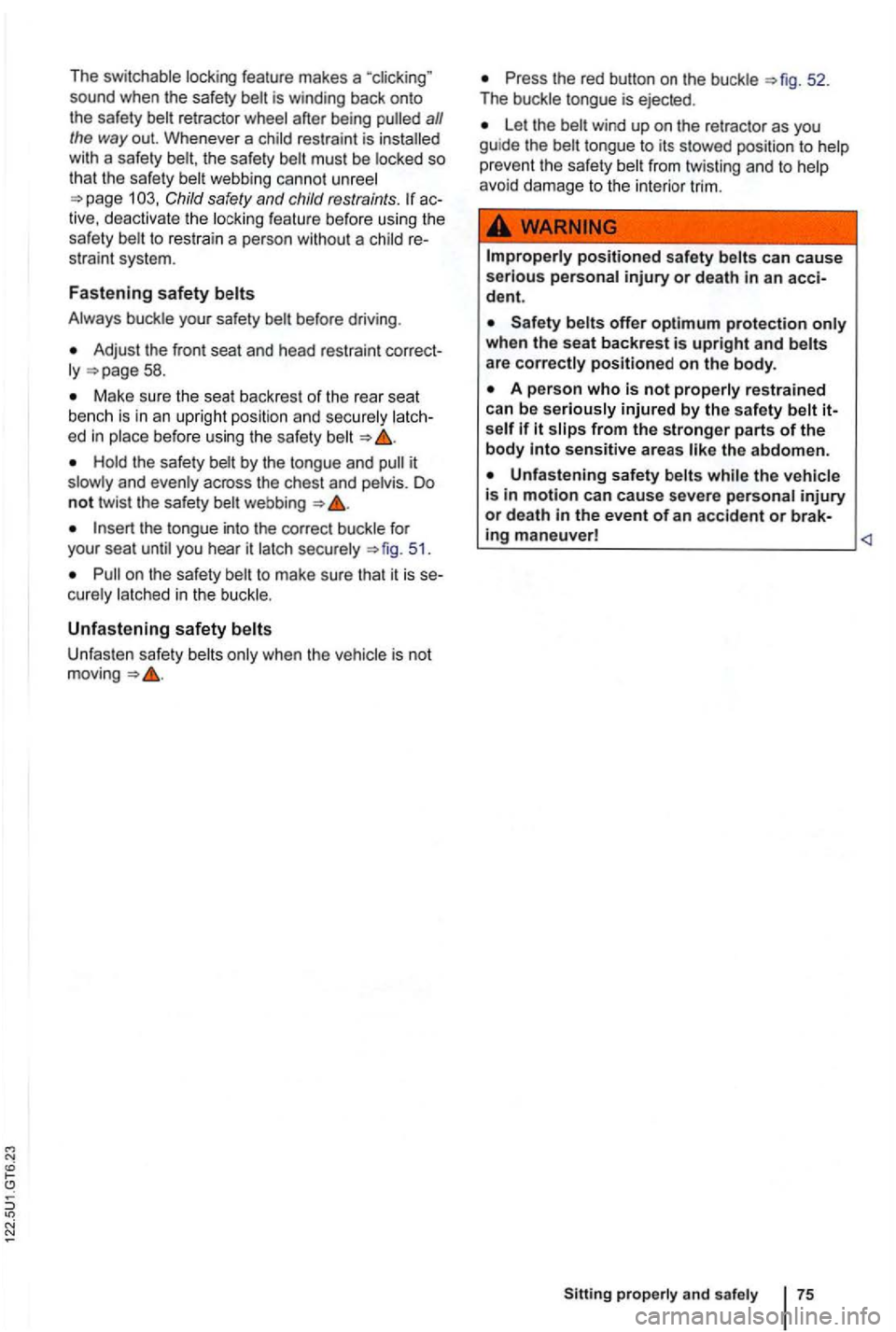
The switchable locking feature makes a sound when the safety a// the way out. When ever a child restraint is with a safe ty belt , the safety belt must be locked so
that the safe ty webbing cannot unreel 103, Child safety and child restraints. ac
tive, deactivate t he locking feature before us ing the safety belt to restrain a person without a chi ld re
straint system .
Fastening safety belts
Always buckle your safety belt before driving.
Adjust the front seat and head restraint correct
ly
Make sure the seat backrest of the rea r sea t
benc h is in an upright position and sec urely latch
ed in place be for e using th e sa fety
Hold the safety belt by the tongue and
51.
on the safety to make sure that it is securely latche d in the buckle .
Unfastening safety belts
Unfasten safety only when the vehicle is not
Press the red button on the buckle 52.
T he buckle tongue is ejected .
Let the belt wind up on the retractor as you
gu ide the belt tongue to its stowed position to help
preve nt th e safety belt from twisting an d to help
avoid damage to the interior trim.
Im
properly positioned safety belts can cause serious p ersonal injury or death in a n acci
dent.
Safety belts offer optimum protection only when the seat backrest is upright and belts are correctly positi oned on the body.
slips from the stronger parts of the body sensitive are as like the abdomen.
Page 178 of 516
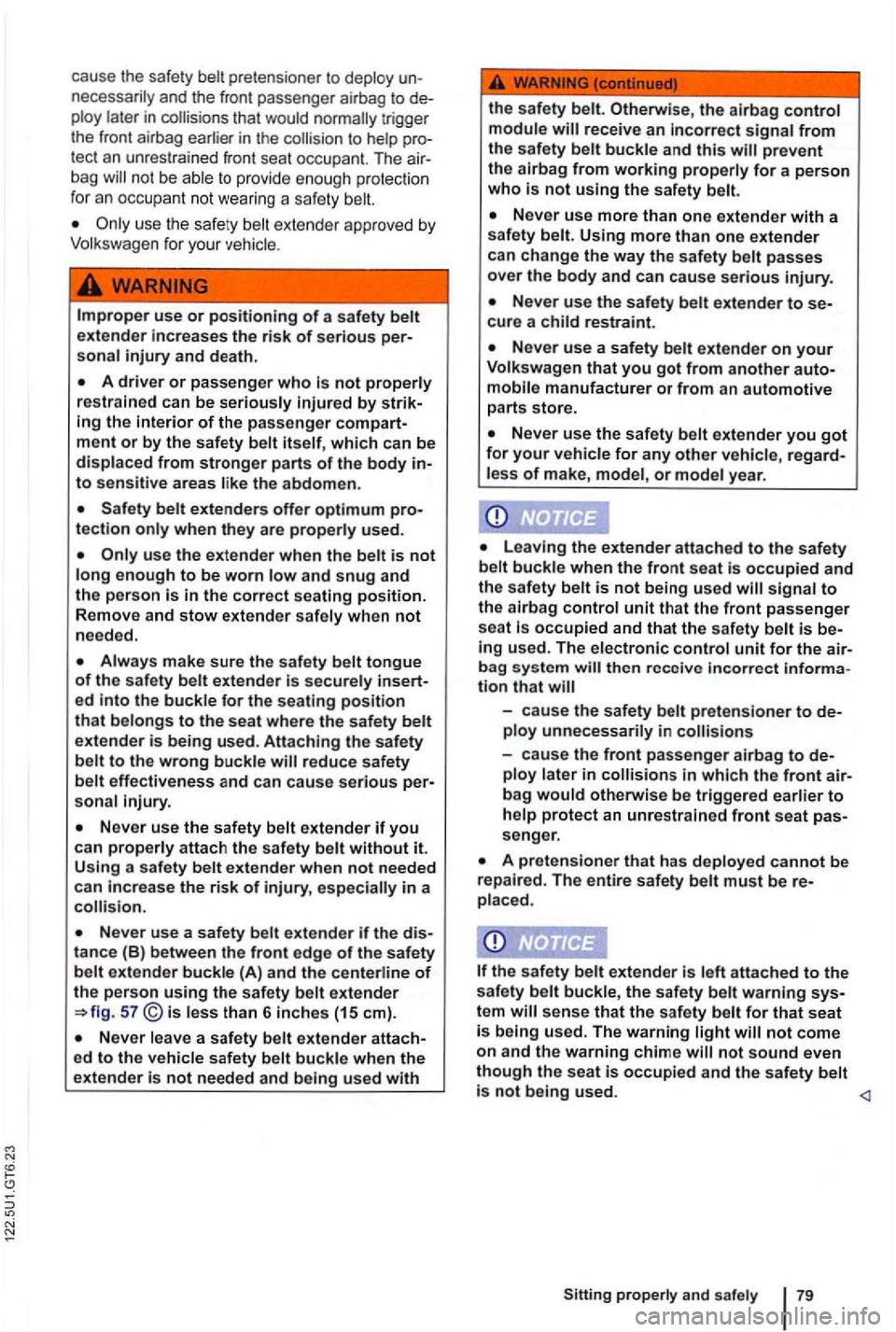
cause the safe ty belt pretensioner to deploy u n
necessar ily and the front passe nger airbag to de
p loy late r in that would
not be ab le to p rovi de enou gh pro tection
f or an occupant not wearing a safety be lt.
use t he safe ty b elt ex te n de r app ro ved by Volkswage n for your veh ic le .
Im
proper use or positioning of a safety belt extender increases the risk of serious per
sonal injury and death .
A driver or passenger who is not properly restrained can be seriously Injured by strik
Safety belt extenders offer optimum protection only when they are properly used.
use th e ex te nder when the belt is not tong enough to be worn tow and snug a.n.d the person the correct seating
Always make sure the safety belt tongue of the safety belt extender the buckle for the seating position that belongs to the seat where the safety belt extender is being used. Attaching the safety belt to the wrong buckle will reduce safety
belt effectiveness and can cause serious per
sona l injury.
Never use a safety belt extender if the distance (B) between the front edge of the safety belt extender buckle (A) and the centerline of the person using the safety belt extende r less than 6 inches (15 em).
Never leave a safety belt extender attached to the vehicle safety belt buckle when the
extender is not needed and being used with the
safety belt.
the airbag control module will receive an incorrect signal from the safety belt buckle and this will prevent
the alrbag from working properly for a person who is not usi ng the safe ty belt.
Never use the safety belt extender to se
cure a child restraint.
Never use the safet y belt extender you got for your vehicle for any other vehicle, regardless of make, model, or model year.
beused. The elect ronic control unit for the air
bag system will then receive incorrect informa
tion that will
- cause the safety belt pretensioner to deploy unnecessarily in collisions
-cause the fron t passenger alrbag to deploy la ter in collisions
A pretens ioner that has deployed cannot be
repaired . The entire safety belt must be re
placed .
being used. The warning
Page 181 of 516
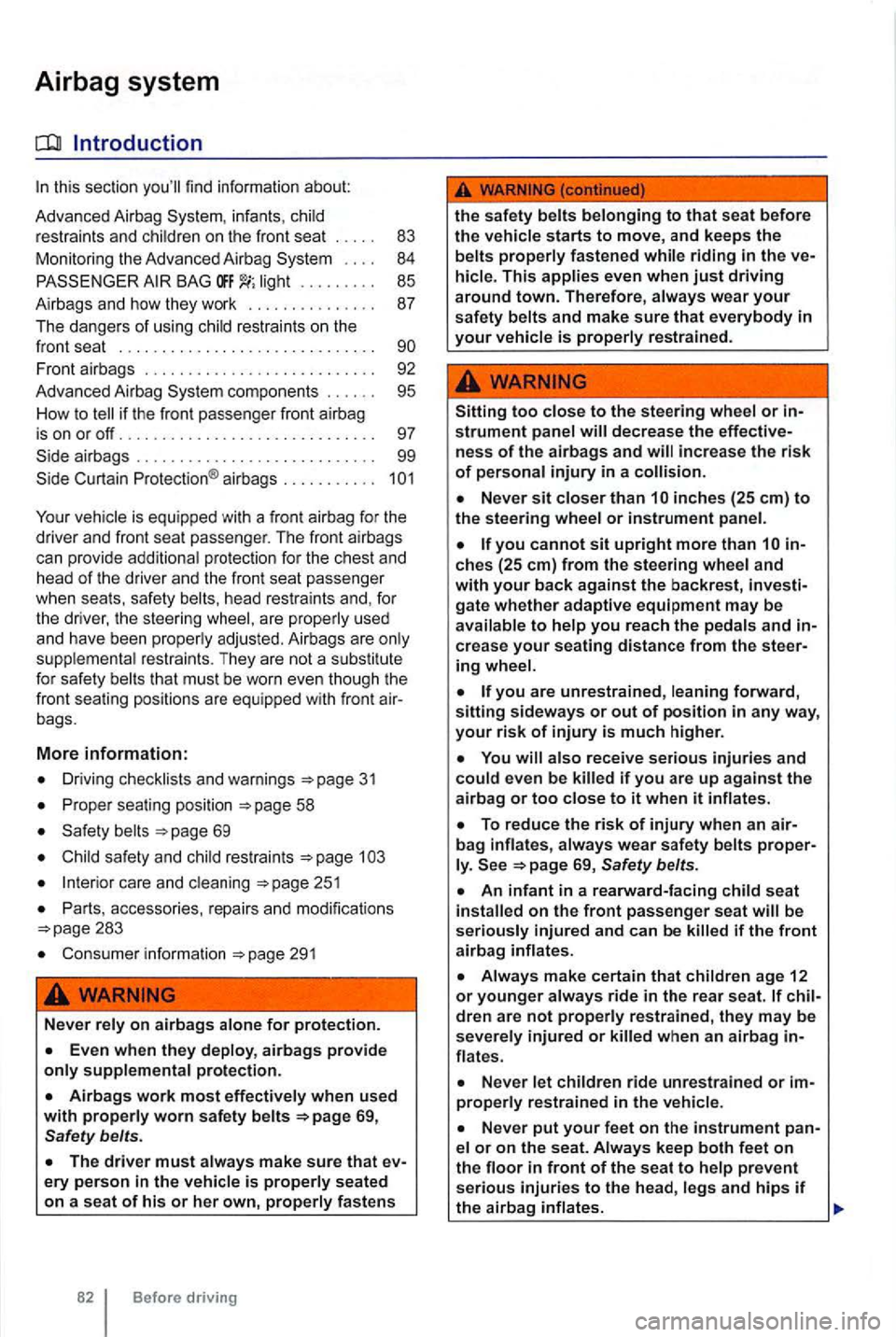
Airbag system
infants, rest ra ints and
. . . . 84
BAG . . . . . . . . . 85
Airbags and how they wo
rk . . . . . . . . . . . . . . . 87
The dangers of usi
ng restra ints o n the
front seat . . . . . . . . . . . . . . . . . . . . . . . . . .
F ront airbags . . . . . . . . . . . . . . . . . . . . . . . . . . . 92
Advanced Airbag
is equipped with a front airbag for the
drive r and front seat passe nger. The front airbags
can provide
head restraint s and , fo r
t h e driver , th e steer ing are used
and have been
restraints . They are not a substitute
for safety that must be worn even th ough the
f ro nt seat ing positions are equipped with front air
bags.
More information:
Driving 31
Prop er seating position
Parts , acc essor ies, repairs and modifications
Consumer inf ormation
airbags provide
worn safety 69, belts.
make sure that ev
ery p erson in the fa stens
82 Before driving
the safety
This even when just driving around town. Therefore ,
is
too
increase the risk of personal injury in a
or instrument
you cannot sit upright more than inches (25 em) from the steering and with your back against the backrest, inves tigate whether adaptive equipment may be you reach the and increa se your seating distance from the steering
you are unrestrained ,
re ceive serious injuries and if you are up agains t the
airbag or too to it when it
proper69, belts.
sea t on the front passe nger sea t be
seriously injured and ca n be
make certain that
dren are not properly res trained , they may be
seve rely injured or
in front of the seat to